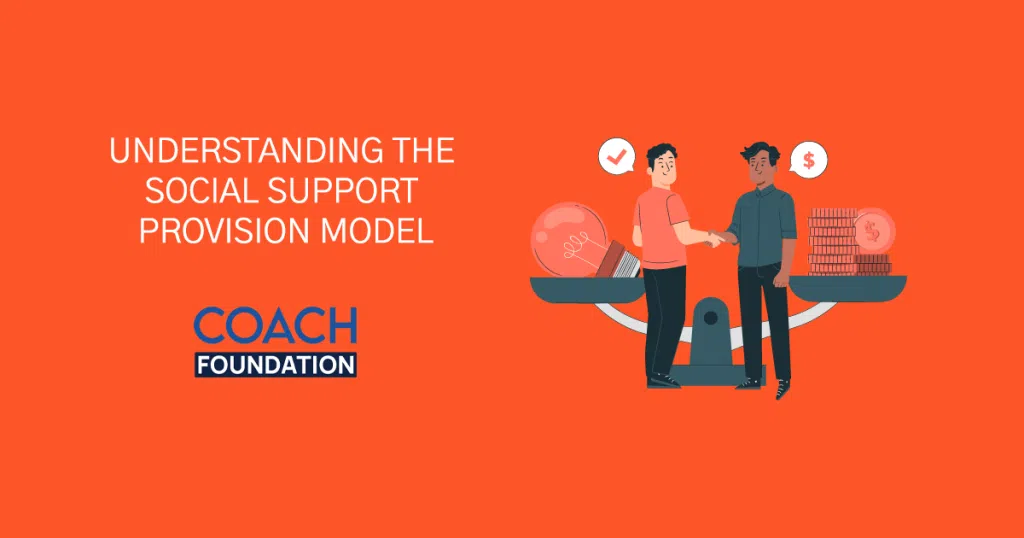Blog » Coaching Models and Techniques » Understanding The Social Support Provision Model
Understanding The Social Support Provision Model
The Social Support Provision Model is a framework for comprehending how people provide and receive social support in various social contexts. It asserts that social support is a multidimensional concept that can come from a variety of sources, including family, friends, and professionals.

The model highlights the importance of understanding the different types of social support as well as the role of individual and contextual factors in the provision and receipt of support. Ultimately, the Social Support Provision Model can be used to inform interventions aimed at enhancing social support and improving well-being in individuals and communities.
In this blog, we’ll explore:
1. What is the social support provision model
2. How does the social support provision model work
3. Core Concepts of social support provision model
5. Application of social support provision model to life coaching
What is the Social Support Provision model
The social support provision model is a theoretical framework used to understand the process of social support provision in different social contexts.
Social support is defined as the assistance, care, and resources provided by others to promote an individual’s well-being. The model contends that social support is a multidimensional construct that can come from a variety of sources, including family, friends, and professionals.
The model highlights the importance of understanding the social support provision process, which involves three main components: the provider, the recipient, and the supportive exchange.
The provider is the individual or group that offers social support, while the recipient is the individual who receives it. The term “supportive exchange” refers to the dynamic interaction between the provider and the recipient, which can depend on a variety of individual and environmental factors.
The social support provision model also emphasizes the role of individual and contextual factors in social support provision. Individual factors, such as personality, coping style, and social network, can affect the provision and receipt of social support. Contextual factors, such as cultural norms, social policies, and economic resources, can also impact the availability and quality of social support.
How the social support provision model works
The Social Support Provision Model is a framework that explains the process of social support provision in different social contexts. Social support is defined as the assistance, care, and resources provided by others to promote an individual’s well-being. The model explains that social support is a multidimensional construct that can come from a variety of sources, including family, friends, and professionals.
The model works by breaking down the social support provision process into three components: the provider, the recipient, and the supportive exchange. The provider is the individual or group that offers social support, while the recipient is the individual who receives it. The term “supportive exchange” refers to the dynamic interaction between the provider and the recipient, which can depend on a variety of individual and environmental factors.
Individual and contextual factors can also impact the provision and receipt of social support. For example, an individual’s personality, coping style, and social network can influence their ability to provide and receive social support. Similarly, contextual factors such as cultural norms, social policies, and economic resources can affect the availability and quality of social support.
Overall, the social support provision model provides a useful framework for understanding the complex process of social support provision. By identifying the different components and factors involved, the model can be used to inform interventions aimed at enhancing social support and improving well-being in individuals and communities.
Elements of The Social Support Provision Model
The Social Support Provision Model consists of several key elements that influence the provision and receipt of social support. These elements include provider characteristics, recipient characteristics, and contextual factors.
Provider characteristics: These refer to the personal qualities and resources that social support providers bring to a relationship. These may include empathy, communication skills, knowledge and experience, and the availability of time and resources. Provider characteristics can have a significant impact on the quality and effectiveness of the support provided.
Recipient characteristics: These refer to the personal qualities and resources of the individual seeking social support. These may include their level of social support, coping strategies, personality traits, and the nature and severity of their stressors. Recipient characteristics can influence the type and amount of social support that is most helpful to them.
Contextual factors: These refer to the broader social, cultural, and environmental factors that affect the provision and receipt of social support. These may include cultural norms, institutional policies and practices, economic and political conditions, and the availability of social support resources in a given community. Contextual factors can shape the nature and effectiveness of social support interventions and should be carefully considered when designing and implementing support programs.
Functions of social support
The Social Support Provision model is a valuable framework for enhancing social support interventions, understanding social support processes, informing practice with diverse populations, and identifying facilitators and barriers to providing effective social support.
Enhancing Social Support Interventions: The Social Support Provision model helps to enhance social support interventions by providing a systematic and comprehensive understanding of the types of social support that people need and how they can receive it. The model identifies four main types of social support: emotional, informational, tangible, and companionship support. Additionally, it acknowledges that a variety of people—including family, friends, peers, and professionals—can offer social support.
Understanding Social Support Processes: The Social Support Provision model also helps to understand the social support processes by which people give and receive social support. The model identifies three key stages in the social support process: the initiation stage, the maintenance stage, and the termination stage. Each stage involves different processes and challenges, and understanding these processes can help improve the effectiveness of social support interventions.
Informing Practice with Diverse Populations: The Social Support Provision model is also useful for informing practice with diverse populations. The model recognizes that social support needs and processes may vary across different populations, including ethnic and cultural groups, age groups, and people with different health conditions. Understanding these variations can help tailor social support interventions to meet the specific needs of different populations.
Identifying Facilitators and Barriers: Finally, the Social Support Provision model can help identify facilitators and barriers to providing effective social support. Facilitators may include factors such as positive relationships, effective communication, and access to resources. Barriers may include factors such as stigma, a lack of resources, and cultural differences. Understanding these facilitators and barriers can help develop strategies for overcoming obstacles and promoting effective social support.
Applying the social support provision model to life Coaching
The Social Support Provision model can be applied to coaching as a framework for enhancing the effectiveness of coaching interventions, understanding the social support needs of clients, informing coaching practice with diverse populations, and identifying facilitators and barriers to providing effective coaching support.
Life coaching is a process that provides support, guidance, and feedback to the client and helps them identify and overcome obstacles to success. The Social Support Provision model can help coaches provide effective support to their clients by identifying the types of social support that clients may need and the sources from which they can receive it.
For example, a coach working with a client who is struggling with work-life balance may identify that the client needs emotional support in the form of encouragement and empathy. The coach may also recognize that the client could benefit from informational support in the form of time management strategies and resources. The coach can then provide these types of support to the client and help them develop a plan for achieving a better work-life balance.
Additionally, the Social Support Provision model can help coaches understand the social support processes involved in coaching, such as the initiation, maintenance, and termination stages. By understanding these processes, coaches can help clients overcome challenges and sustain their progress toward their goals.
Conclusion
The social support system model posits that people benefit from having access to a network of supportive relationships. The availability of social support can provide people with a sense of belonging, enhance their self-esteem, and provide resources for coping with stressors.
The effectiveness of social support may vary depending on factors such as the quality of relationships, cultural context, and individual differences. Overall, the social support system model underscores the importance of maintaining and strengthening social connections as a means of promoting well-being.
I look forward to reading your thoughts on this blog. Feel free to add your own thoughts and observations below.
Frequently Asked Questions (FAQs)
1. What is the concept of the social support provision model?
The social support provision model is a framework that explains how social support can be provided to individuals during times of need. It emphasizes the importance of understanding the different factors that influence the giving and receiving of social support, such as individual characteristics, environmental factors, and the type of support needed.
2. What are a few examples of the social support provision model?
Here are a few examples of the social support provision model:
1. A friend offering emotional support to someone going through a difficult time, such as a breakup or the loss of a loved one.
2. A community organization providing tangible support, such as food or clothing, to individuals who are experiencing financial hardship.
3. A therapist offering informational support to a client who is struggling with a mental health issue by providing education and resources on coping strategies.
3. What are the pros and cons of the social support provision model
Pros:
1. It promotes social connectedness and helps individuals feel supported during times of need.
2. It can improve physical, emotional, and mental well-being by providing various forms of assistance.
3. It recognizes the importance of creating a supportive environment that fosters supportive relationships.
Cons:
1. It can create a reliance on social support rather than self-reliance.
2. They may not be available or accessible to individuals who lack supportive relationships or resources.
3. It can be challenging to navigate social networks and receive the specific type of support needed.

ABOUT SAI BLACKBYRN
I’m Sai Blackbyrn, better known as “The Coach’s Mentor.” I help Coaches like you establish their business online. My system is simple: close more clients at higher fees. You can take advantage of technology, and use it as a catalyst to grow your coaching business in a matter of weeks; not months, not years. It’s easier than you think.
AS SEEN ON





